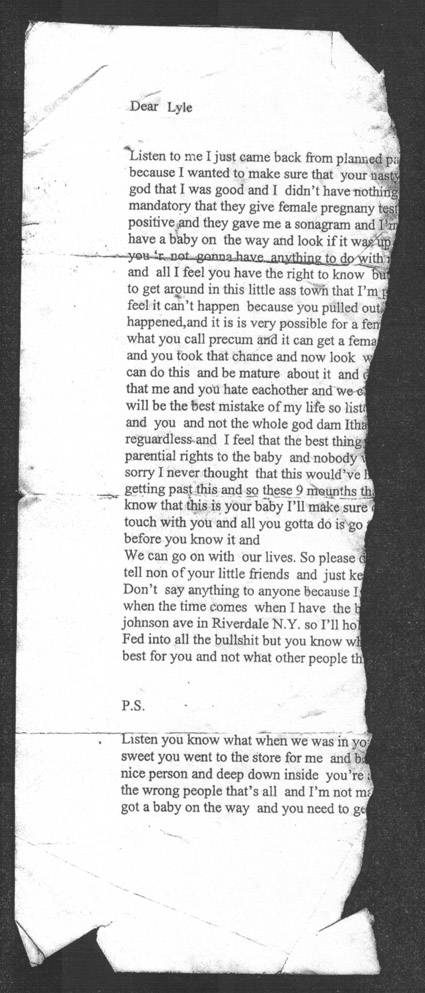Some of you may remember a column I wrote for SportsBubbler back in December in which I urged Milwaukee Bucks rookie guard Brandon Jennings to stop tweeting. (After falling victim to a hoax, he has since done so – at least publicly.) As a result of that article, I got the chance to speak with writer Davy Rothbart, who just happened to be writing a feature on Jennings for GQ Magazine. (He mentioned that it will be in the April edition of GQ. I have yet to ask him when my photo shoot will take place – I imagine it’s in the works.)
What I didn’t realize at the time is that Davy Rothbart is the editor of FOUND Magazine, a publication that collects various letters, postcards, pictures, shopping lists, and other items that people just randomly find on the street, then compiles them. I admit I\’m really late to this party – by the time I had heard of FOUND, two “best of” books had been printed and become bestsellers, and other people I knew had all heard of the phenomenon that is the magazine. (I even ended up talking with my local librarians about it, as I overheard them talking about all the crazy notes and things they find in books when people return them.)
I went out and bought both books, and I was stunned at some of the items people had found and turned in to the magazine. Some of the most moving entries are heartfelt notes people had written to others – some are merely comical in that they completely lack context. (Such as the note left on someone’s car that urges someone to “Please Do Not Put Crab on my Car. Just cut it out!”)
Aside from just the prurient thrill of being able to gaze into someone’s life for a brief moment, some of the entries really serve as a mental exercise in time and space. When people think about the problems in their lives, usually they can analyze them in terms of: 1) how they got into the predicament, 2) what all the relevant information to the problem is, and 3) what they need to do to get out of it.
And yet reading these letters allows for none of these three analytic tools. You’re dropped right into the middle of a problem in someone’s life – you don’t know how that person got into trouble, you only know the information they have scrawled (inevitably, misspelled) onto a piece of paper, and you will never know if they got out of it. Whether it’s a love note or a plea for a loved one to send money, or a threat to beat someone’s ass, there’s always a beginning, middle and an end – and you’re only getting one person’s interpretation of the middle.
There’s one entry that\’s so perfect, though, I had to share it here. It’s called “Dear Lyle,” and it’s clearly a letter written by a confused, pregnant young girl to her boyfriend. (It was found by Sam Costello, of Ithaca, New York.) I’ll just wait here in my slippers and smoking jacket while you read it….

OK, I just read it again, too. And it’s almost too perfect – too heartbreaking – to be real.
First, the fact that it’s on half a ripped piece of paper is so representative of the content of the letter itself, it\’s almost eerie. Reading only half of what this young woman is saying makes your brain jerk frantically around from topic to topic, much as hers probably was when she was writing it. The fact that half her plea is missing almost makes you feel as hurried and confused as she was while she was making her decision to keep the child. (For me, it recalls Tom Wolfe’s “Electric Kool Aid Acid Test,” in which Wolfe writes in such a way to make your mind careen around as if it were on LSD – which is what the book is all about. It is also my favorite book.)
Furthermore, the ripped paper is also symbolic of this relationship as it moves forward. It’s pretty clear the young mother is telling Lyle to stay away, so “we can go on with our lives.” So, in effect, this child is going to have half a family – much as the note itself has been torn in half. It’s almost too perfect.
And so here you are, immediately dropped into the life of a scared young girl trying to tell her child’s father that she’s going to go it alone. And doing so with a disjointed, poorly spelled, crumpled up letter, that apparently Lyle didn’t think enough of to keep in one piece and/or keep in his possession.
Surely, one could sit for a while and think about possible scenarios that led up to this pregnancy, and what occurred afterward. In fact, Rothbart published a book where people of note write about their favorite found items, and build stories around the details of what they imagine to be the genesis of such items. (It includes an essay by Chuck Klosterman, who I’m pretty sure would write something for Legless Nun Magazine at this point. The guy is everywhere.)
In case I’m not doing justice to the whole FOUND phenomenon, here’s a video of one of Rothbart’s appearances on Letterman. Good stuff.
Leave a Reply